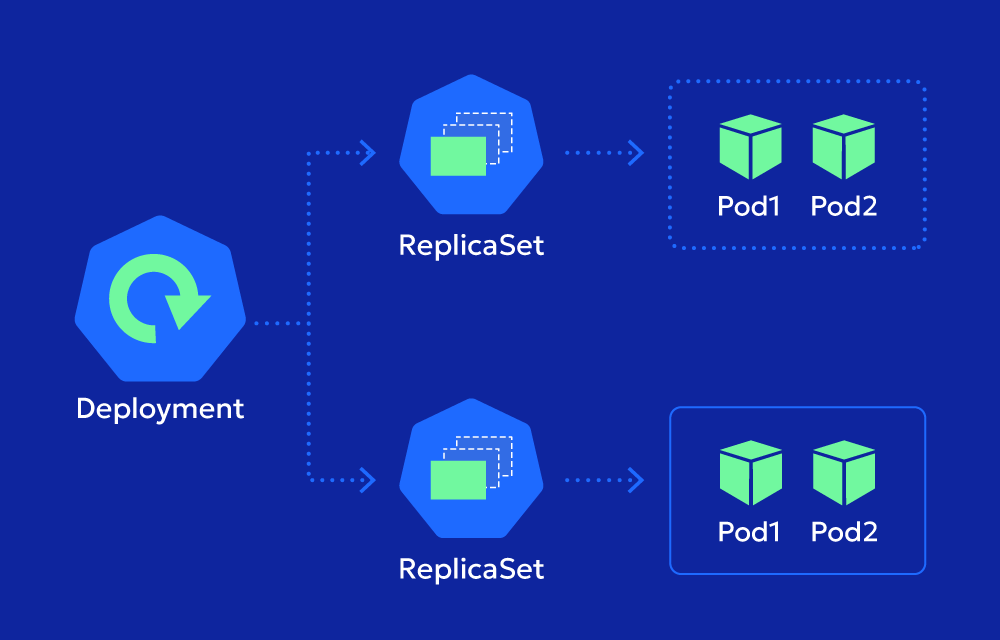In short, it’s the foundation for running stateless applications in Kubernetes—automated, versioned, and scalable.
If you’re manually applying Pod specs in production, you’re doing it wrong. Deployments are how real-world Kubernetes apps are managed.
Why Deployments Matter
Deployments solve a handful of common challenges:
- Self-healing: If a pod crashes, the Deployment will automatically create a new one.
- Declarative updates: You define what you want, and the Deployment controller figures out how to get there.
- Version control: You can roll forward or back between versions of your app.
- Scalability: Easily increase or decrease replicas on demand.
They’re the safest and most repeatable way to roll out workloads in a Kubernetes environment.
Anatomy of a Deployment
Let’s start with a simple Deployment YAML:
apiVersion: apps/v1
kind: Deployment
metadata:
name: hello-world
spec:
replicas: 3
selector:
matchLabels:
app: hello
template:
metadata:
labels:
app: hello
spec:
containers:
- name: hello-container
image: nginx:1.25
ports:
- containerPort: 80
Key parts:
replicas: Number of desired podsselector: Matches the pods managed by this Deploymenttemplate: Describes the pod spec—containers, images, ports, volumes, etc.
Apply it with:
kubectl apply -f deployment.yamlAnd scale it with:
kubectl scale deployment hello-world --replicas=5Deployment Strategies in Kubernetes
Kubernetes Deployments support several rollout strategies, each with trade-offs in speed, availability, and risk. Choosing the right one depends on your app’s criticality, how tolerant it is to downtime, and whether you can test updates safely before going live.
1. Rolling Update (Default)
The default and most commonly used strategy. It updates pods incrementally to avoid downtime.
strategy:
type: RollingUpdate
rollingUpdate:
maxSurge: 1
maxUnavailable: 1
Use when:
- Your app is stateless and can handle being swapped in and out
- You want continuous availability during updates
2. Recreate
Stops all old pods before starting new ones. Good for workloads that can’t run multiple instances at once.
strategy:
type: RecreateUse when:
- Your app uses exclusive resources or can’t run multiple versions side-by-side
3. Blue-Green Deployment (requires extra setup)
Run both old and new versions side-by-side, and switch traffic once the new version is validated.
Tools needed:
- Two Deployments or ReplicaSets
- A Service to point traffic
Use when:
- You need zero-downtime and fast rollback capabilities
More: Blue/Green Deployments
4. Canary Deployment (requires additional tools)
Gradually route traffic to the new version in small percentages (10%, 50%, etc.).
Recommended tools:
Use when:
- You want fine-grained rollout control based on metrics or performance
Rollbacks
Mistakes happen. Rollbacks let you revert to a stable version instantly:
kubectl rollout undo deployment hello-worldList history:
kubectl rollout history deployment hello-worldBest Practices for Using Deployments
1. Use Readiness Probes
Avoid sending traffic to pods that aren’t ready:
readinessProbe:
httpGet:
path: /
port: 80
initialDelaySeconds: 5
periodSeconds: 10
More: Readiness Probes
2. Use Immutable Image Tags
Avoid :latest. Always tag with explicit versions:
image: nginx:1.25.13. Define Resource Requests and Limits
resources:
requests:
memory: "64Mi"
cpu: "250m"
limits:
memory: "128Mi"
cpu: "500m"
4. Separate Secrets and Config
Use ConfigMaps and Secrets instead of baking config into Deployments.
More:
5. Avoid Label Mismatch
Ensure that selector.matchLabels matches template.metadata.labels exactly. Otherwise, your Deployment won’t manage pods correctly.
Monitoring and Observability
Check Deployment status with:
kubectl get deployment hello-world
kubectl rollout status deployment hello-world
Use tools like:
Final Thoughts
A Kubernetes Deployment is one of the most powerful tools in your toolbox. It gives you a clean way to scale, update, and recover your application with minimal disruption.
Whether you’re deploying to dev, staging, or production, the same controller handles it all. Use it well, and your updates will be safer, your rollouts cleaner, and your apps more resilient.



